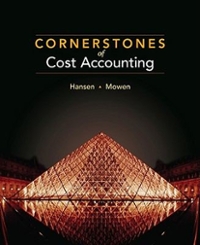Question
CLARINDA COMMUNITY HOSPITAL is a 230-bed, not-for-profit, acute care hospital located in Clarinda, Iowa. The city is a typical Midwestern county seat and farming community
CLARINDA COMMUNITY HOSPITAL is a 230-bed, not-for-profit, acute care hospital located in Clarinda, Iowa. The city is a typical Midwestern county seat and farming community best known as the birthplace of Glenn Miller, the famous big band leader of the late 1930s and early 1940s. Clarinda carries more than 10,000 different items of inventory that vary widely in price, order lead times, and stockout costs. (Stockout costs are the total costs that result from running out of stock of a particular inven- tory item, including higher costs of service caused by scheduling delays or emergency replenishments as well as the costs associated with negative patient outcomes and potential lawsuits.) It uses the activity-based costing (ABC) method of inventory classification, also called "selective inventory control," along with a variety of inventory-control methods to manage its different inventory items. The ABC classification system works in this way: Clarinda maintains data on the average annual usage and unit cost of each inventory item, which typically is called a stock-keeping unit (SKU). Then, the dollar usage (Average annual usage x Unit cost) is calculated for each SKU. Next, these amounts are converted into percentages of total dollar usage, and the SKUs are arrayed from highest to lowest percentage. The SKUs are then divided into three groups (or classes)-labeled A, B, and C-using the general guidelines provided in exhibit 28.1. To better use the limited resources available for inventory management, Clarinda's managers focus most of their attention on Class A items. The usage rates, stock positions, and delivery times for SKUs in this class are reviewed on a biweekly basis, with control and ordering system data adjusted as necessary. Class B items are reviewed every quarter, while Class C items are reviewed semiannually. Even though this process has served Clarinda well, Marco Munoz, its new chief financial officer, thinks the hospital is carrying excess inventories. He notes that Clarinda has never come close to having a stockout, even when it has been running near 100 percent occupancy. He believes that a thorough review should be undertaken of all Class A items and that inven- tory turnover might be increased by 25 percent, and hence might lower inventory carrying costs, by trimming current stocks. To convince Clarinda's CEO, Marco plans to perform a demonstration inventory analysis that focuses on the forms used by the surgical intensive care unit (SICU). Different forms are required for almost every aspect of SICU operations, including records of patient progress; requests for lab tests, blood products, and medications; nurse and physician notes; and transfer/ discharge instructions. Exhibit 28.2 shows inventory usage and cost data on the SICU's 25 forms. To begin his demonstration analysis, Marco plans to conduct a new ABC analysis on the SICU's inventory. (Clarinda is in the process of converting to web-based forms as part of the transition to electronic medical records, but the paper forms will still be used for several years.) As part of its commitment to supporting the local economy, Clarinda currently uses a single local source for all of the SICU's forms: Atwood Printing and Office Supplies (Supplier A). Supplier A requires a $25 set-up fee on each order, in addition to the cost per unit. Clarinda is considering using a national supplier, Bateman Medical Office Products (Supplier B), which charges no set-up fee but does charge $50 to cover postage and han- dling. Supplier B takes three days to deliver the forms, as opposed to only one day for Supplier A. Processing each order will cost Clarinda another $25, regardless of which supplier is used. Thus, the total order cost is $50 for Supplier A and $75 for Supplier B. Marco's ultimate goal is to use economic ordering quantity (EOQ) concepts to select the supplier for all forms used by the SICU. His primary areas of concern are (1) the number of orders placed each year, (2) reorder points (in units), and (3) total inventory costs. As part of the demonstra- tion analysis, Marco will focus on the form used to order blood products from Clarinda's blood bank (SKU number 53104 in exhibit 28.2). The data



Step by Step Solution
There are 3 Steps involved in it
Step: 1

Get Instant Access to Expert-Tailored Solutions
See step-by-step solutions with expert insights and AI powered tools for academic success
Step: 2

Step: 3

Ace Your Homework with AI
Get the answers you need in no time with our AI-driven, step-by-step assistance
Get Started


